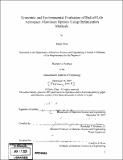Economic and environmental evaluation of end-of-life aerospace aluminum options using optimization methods
Author(s)
Chen, Emily, S.B. Massachusetts Institute of Technology
DownloadFull printable version (3.845Mb)
Other Contributors
Massachusetts Institute of Technology. Dept. of Materials Science and Engineering.
Advisor
Randolph E. Kirchain, Jr.
Terms of use
Metadata
Show full item recordAbstract
The benefits of recycling have long been understood and the conspicuous energy savings of secondary aluminum production have caused aluminum recycling to increase. Obsolete aircraft are a valuable source of aluminum scrap and recent efforts to fortify the aerospace aluminum recycling infrastructure have drawn attention to the potential of sophisticated sorting methods to maximize the economic gain of using aerospace scrap in secondary production. The aim of this research was to use linear optimization to assess the economic viability of sorting technologies for enabling wrought products in general and aerospace alloys in particular to be recycled back to high value applications. A chance-constrained model was used to select the alloys that consumed the largest quantity of aerospace alloys in their production, thereby establishing a strategic portfolio of finished goods. Ten of the fifteen alloys in the portfolio were of the 2xxx and 7xxx alloy series that are standard in the production of aerospace components. An aerospace end-of-life case study was performed in which cases varied by their input scrap streams, each having a compositional uncertainty associated with the different degrees of sorting that methods currently in use and technologies in development can achieve. The chance-constrained model calculated the production cost for each case and determined that when aerospace components were identified to the precision of individual alloys, the production cost was 20.87% lower than the cost for primary production. Using automatically sorted scrap input yielded a production cost that was 5.34% lower than the cost of primary production. (cont.) Before concluding that the development of sorting technology should only be pursued with a budget of $0.0743/kT, a break-even point calculated by the model, it is necessary to take into account the fact that dismantled scrap is more expensive than sorted. In addition to performing sensitivity analysis on the scrap prices, future work should test the production of different portfolios of finished goods and take varying demand for each alloy into consideration.
Description
Thesis (S.B.)--Massachusetts Institute of Technology, Dept. of Materials Science and Engineering, February 2008. "December 18, 2007." Includes bibliographical references (leaves 47-48).
Date issued
2008Department
Massachusetts Institute of Technology. Department of Materials Science and EngineeringPublisher
Massachusetts Institute of Technology
Keywords
Materials Science and Engineering.